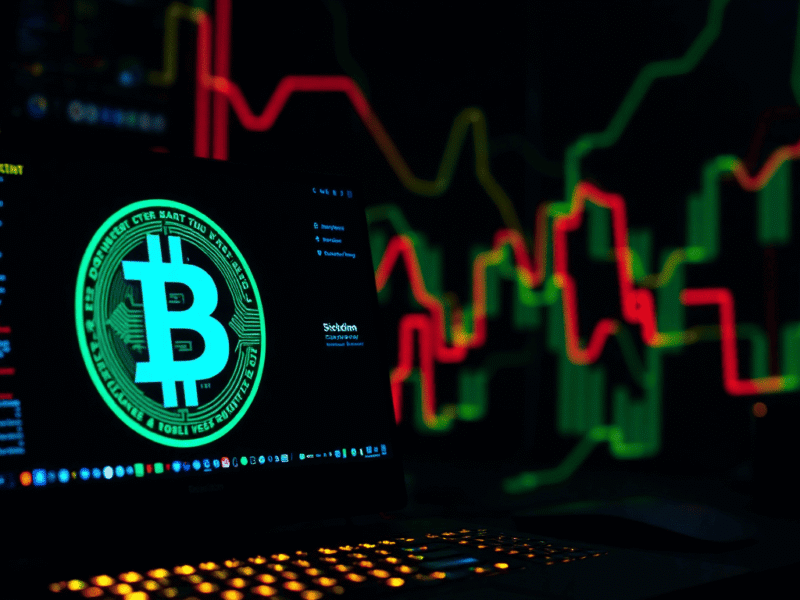In the exhilarating world of crypto trading, the potential for high returns is often juxtaposed with significant risks. The volatile nature of cryptocurrencies makes risk management not just a luxury but an absolute necessity for traders. Enter the realm of automation, a game-changer in the crypto universe. Automation, in the context of crypto trading, refers to the use of sophisticated algorithms and software to execute trades, manage portfolios, and most importantly, mitigate risks. The rise of automated cryptocurrency trading apps has empowered traders to make more informed decisions, backed by data and real-time analysis. By intertwining risk management with automation, traders can navigate the tumultuous waters of the crypto market with increased confidence and precision. The importance of this synergy cannot be overstated, as it holds the key to maximizing profits while safeguarding investments.
The Volatile Nature of the Crypto Market
The crypto market, with its rapid price movements and unpredictable shifts, is often likened to a rollercoaster ride. This inherent volatility stems from a myriad of factors, including regulatory news, technological advancements, market sentiment, and global economic events. Unlike traditional markets, cryptocurrencies can experience drastic price changes within mere minutes, leading to significant “crypto fluctuations.”
For traders, this volatility is a double-edged sword. On one hand, the potential for high returns is tantalizing. A well-timed trade during a market upswing can yield substantial profits. On the other hand, the same volatility can lead to considerable losses, especially for those unprepared or lacking a solid risk management strategy.
The implications of this market behavior are profound. Traders must be constantly vigilant, staying updated with market news and trends. They must also be mentally prepared for the market’s capricious nature, ensuring they don’t make impulsive decisions driven by fear or greed. In essence, while the volatile nature of the crypto market offers unparalleled opportunities, it also demands a heightened level of caution and strategy from its participants.
Automated Risk Management Strategies
In the dynamic landscape of crypto trading, automated strategies have emerged as powerful tools to navigate the market’s unpredictability. These strategies, driven by advanced algorithms and technology, aim to optimize returns while minimizing potential losses.
Diversification is a foundational principle in investment, and its importance is magnified in the volatile crypto space. Automated platforms often facilitate diversification by allowing traders to allocate their investments across a diverse range of cryptocurrencies. By spreading assets, traders can mitigate the adverse effects of a poor-performing cryptocurrency, ensuring that a dip in one asset doesn’t lead to a significant portfolio loss.
Hedging bots are another innovative solution in the automated trading toolkit. These bots are designed to protect investments against unfavorable market movements. For instance, if a trader has a long position in a particular cryptocurrency, a hedging bot can automatically set up a counteracting short position. This dual approach acts as a safety net, ensuring that potential losses from one position are offset by gains in the other.
Statistical arbitrage is a more advanced automated strategy, rooted in complex mathematical models. In essence, it involves simultaneously buying and selling multiple cryptocurrency pairs based on their historical price relationships. When these relationships deviate from their historical norms, trading opportunities arise. Bots equipped with statistical arbitrage algorithms can quickly identify and capitalize on these price discrepancies, executing trades at lightning speed.
In conclusion, automated risk management strategies, from diversification to statistical arbitrage, offer traders a sophisticated approach to crypto trading. By leveraging technology and data-driven insights, traders can navigate the market with increased precision, confidence, and potential for profit. As the crypto space continues to evolve, the role of these automated strategies in shaping successful trading journeys will only become more pronounced.
Tools and Features for Automated Risk Management
The realm of automated crypto trading is replete with innovative tools and features designed to bolster risk management. These tools, powered by cutting-edge technology, offer traders a safety net, ensuring that their investments are shielded from the market’s unpredictable swings.
Stop-loss orders stand at the forefront of these tools. As the name suggests, a stop-loss order automatically sells a cryptocurrency when its price drops to a predetermined level. This tool acts as a protective measure, ensuring that traders can cap their potential losses and prevent a downward spiral in a bearish market.
Complementing the stop-loss is the trailing stop order. Unlike a fixed stop-loss, which is set at a specific price, a trailing stop moves with the market. If the price of a cryptocurrency rises, the trailing stop adjusts upwards, locking in potential profits. However, if the price drops, the order triggers, selling the asset and safeguarding the trader’s gains.
The integration of AI in trading has revolutionized risk management. AI-driven platforms analyze vast amounts of data in real-time, predicting market trends and making informed trading decisions. From identifying optimal entry and exit points to adjusting strategies based on market sentiment, AI’s role in enhancing risk management is undeniable.
In essence, the fusion of traditional tools like stop-loss orders with modern innovations like AI creates a robust risk management framework. For traders in the volatile crypto market, these tools are not just conveniences but essential allies in their quest for profitability and security.
Security Concerns in Automated Trading
The allure of automated trading, with its promise of optimized returns and minimized risks, is undeniable. However, as traders increasingly rely on technology, the importance of security in this domain becomes paramount. Automated platforms, while offering efficiency, also present potential vulnerabilities that malicious actors might exploit.
A cornerstone of security in the crypto realm is the cold wallet. Unlike hot wallets, which are connected to the internet and used for daily transactions, cold wallets are offline storage solutions. By keeping assets in cold wallets, traders ensure that their investments are insulated from online threats, hacks, and unauthorized access. In the event of a security breach on a trading platform, assets in cold wallets remain untouched and safe.
Equally vital is the use of strong authentication methods. Simple username-password combinations no longer suffice in today’s sophisticated threat landscape. Two-factor authentication (2FA) has become a standard security measure for many platforms. With 2FA, traders are required to provide two distinct forms of identification before accessing their accounts. This added layer significantly reduces the chances of unauthorized access, even if a malicious actor obtains login credentials.
In conclusion, while automated trading offers numerous advantages, it also necessitates a heightened focus on security. By employing tools like cold wallets and robust authentication methods, traders can ensure that their automated trading journey is not just profitable but also secure. In the ever-evolving world of crypto, where assets can be highly valuable, such security measures are not optional but essential.
Regulatory Landscape and Its Impact
The world of cryptocurrency is in a constant state of flux, and a significant driver behind this dynamism is the evolving regulatory landscape. As governments and financial institutions grapple with the implications of this digital revolution, regulations are continually being formulated, refined, and implemented.
For traders, these regulatory shifts have profound implications. New regulations can redefine what’s permissible, alter trading strategies, and even influence the very viability of certain cryptocurrencies. Automated trading platforms, with their reliance on algorithms and predefined strategies, must be agile. They need to adapt swiftly to regulatory changes to ensure compliance and maintain trading efficiency.
The impact of crypto regulations on automated trading is multifaceted. For instance, a new regulation might limit the leverage offered by exchanges, directly affecting margin trading bots. Similarly, stricter Know Your Customer (KYC) and Anti-Money Laundering (AML) regulations could influence the speed and ease of automated trade executions.
In conclusion, while the promise of automated trading is immense, its success is intricately linked to the regulatory environment. Traders and platforms alike must stay informed, anticipate regulatory shifts, and be prepared to pivot their strategies. In the crypto universe, where change is the only constant, adaptability in the face of regulatory evolution is key.
The Human Element in Automated Trading
In the realm of automated trading, where algorithms and bots dominate, the significance of the human element cannot be understated. While technology offers precision, speed, and data-driven decisions, it lacks the nuance, intuition, and emotional intelligence inherent to human traders.
Emotional intelligence plays a pivotal role in trading success. It’s the ability to recognize, understand, and manage our emotions and to be aware of the emotions of others. In the volatile world of crypto, where market sentiment can shift rapidly, emotional intelligence helps traders navigate fear, greed, and uncertainty. It aids in making informed decisions, preventing impulsive reactions to market highs and lows.
However, striking the right balance between automation and human decision-making is crucial. Automated tools can execute trades at lightning speed, analyze vast datasets, and operate 24/7. Yet, they operate based on predefined parameters and lack the ability to interpret qualitative factors like news sentiment or geopolitical events.
In conclusion, while automation offers unparalleled advantages in crypto trading, the human touch remains irreplaceable. A harmonious blend of technology and human insight ensures that trading strategies are not just data-driven but also emotionally intelligent, leading to more holistic and successful trading outcomes.
Conclusion
Navigating the intricate world of crypto trading requires a blend of technological prowess and human insight. As we’ve explored, automated trading offers a myriad of tools and strategies, from diversification to AI-driven analysis, all designed to optimize returns and mitigate risks. Yet, the volatile nature of the crypto market, coupled with evolving regulations and security concerns, underscores the importance of risk management.
The human element, with its emotional intelligence and intuition, complements the precision of automation, ensuring that trading decisions are well-rounded and informed. As the crypto landscape continues to evolve, the synergy between automation and human decision-making will be pivotal in shaping successful trading journeys.
In summary, while the future of crypto trading is undoubtedly exciting, it’s also fraught with challenges. Embracing robust risk management strategies, both automated and human-driven, will be the cornerstone of success in this dynamic domain.
FAQs
Super vital! Always set a stop-loss. It’s your safety net against volatile market swings. Remember, in crypto, things can go south real quick!
Backtesting is great, but don’t solely rely on it. Past performance isn’t always indicative of future results. Always keep an eye on the market sentiment and adjust accordingly.
Regularly, mate! I’d say at least once a week. Markets evolve, and so should your strategy. Stay agile and adapt to the market’s ebb and flow.
Absolutely! Don’t put all your satoshis in one basket. Diversifying can help spread risk across different assets. It’s a classic risk mitigation tactic.
Use a combo of tight stop-losses and trailing stops. These tools can help safeguard your portfolio from those unexpected and rapid price drops.



